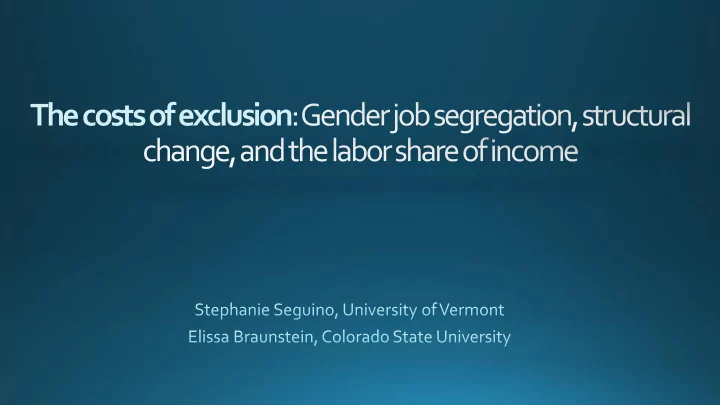

The costs of exclusion
• Inequality BUT • Educational & employment gender gaps gender job segregation
Gender conflictive employment gains? since 1991 Change in women's/men's employment rate 30 20 10 0 -10 -20 -10 0 10 20 Change in men's employment rate Developed countries Developing countries Transition economies
And job segregation is increasing as industrial share of employment falls Industrial sector work declining Women’s relative share of good jobs 20 14.4 13.1 11 10 5.3 4.7 4.1 2.8 0 -10 -14.8 -20 -21.8 -23 -30 -40 -42.8 -43.9 -50 Women's rel. concentration industrial jobs F/M employment rate ratio
macro-structural causes hurt men as well as women by depressing the labor share of income?
industrial sector jobs services & agriculture productivity 85% 68%
• Ratio of market services sector to industrial sector productivity averages 85% across regions. (In Europe/USA, 68%).
Stratification dual labor markets • Dual/segmented labor market theory • Stratification job scarcity
1. Structural transformation and the gender inclusivity of technological change 2. Structural and policy consequences of hyperglobalization • Extent of global integration Some details • 1991-2014, annual observations for two groups: developing and developed countries 3. Economic growth • Country and time fixed effects 4. Labor supply controls
Factor Impact on women’s relative access to good jobs Structural transformation and the gender inclusivity of technological change Industrial employment as a share of total employment Positive: Industrial value added matters a lot less Negative: Given gender stereotypes and segregation, technological Higher capital intensity of production change may hurt women’s access to better jobs Structural and policy consequences of globalization Stronger fiscal policy stances Positive: Austerity detracts from gender equality Net (not total) exports of manufactures Positive: Domestic value added in exports matter, FDI doesn’t Tariffs Positive: Less trade liberalization enhances women’s access Economic growth No effect: Failure of growth to produce sufficient employment also a Per capita GDP growth failure for gender equality Women’s involvement in markets Negative: Given the limited supply of good jobs, associated with Increasing women’s labor force participation increased gender segregation and crowding into bad jobs
increasingly rationed “cost of job loss” fallback positions & BP decline in L share of income
Results: Statistically significant variables only Dependent variable: Fixed effects 2SLS L share of income Women’s rel. Women’s rel. concentration 0.08 0.14 concentration in F/M LFPR industrial sector jobs Industrial VA/GDP Ind. emp/Total emp Ind. value -0.18 -0.26 Inward FDI/GDP added/GDP G. cons/GDP 0.04 0.04 Weighted tariffs Real i rates K/L ratio 0.16 0.16 G cons./GDP Trade/GDP Weighted tariffs *Women’s share of industrial sector jobs may be endogenous, hence 2SLS. Instruments are lagged values of women’s industrial concentration & net mfg. exports/GDP.
• Crowding hurts effect is large 3.1 percentage point decline of L share from 1991-2010. • Expansionary fiscal policies less trade liberalization
integration on inferior terms worsens overall inequality negative effects for aggregate demand & growth. gender conflictive .
Recommend
More recommend